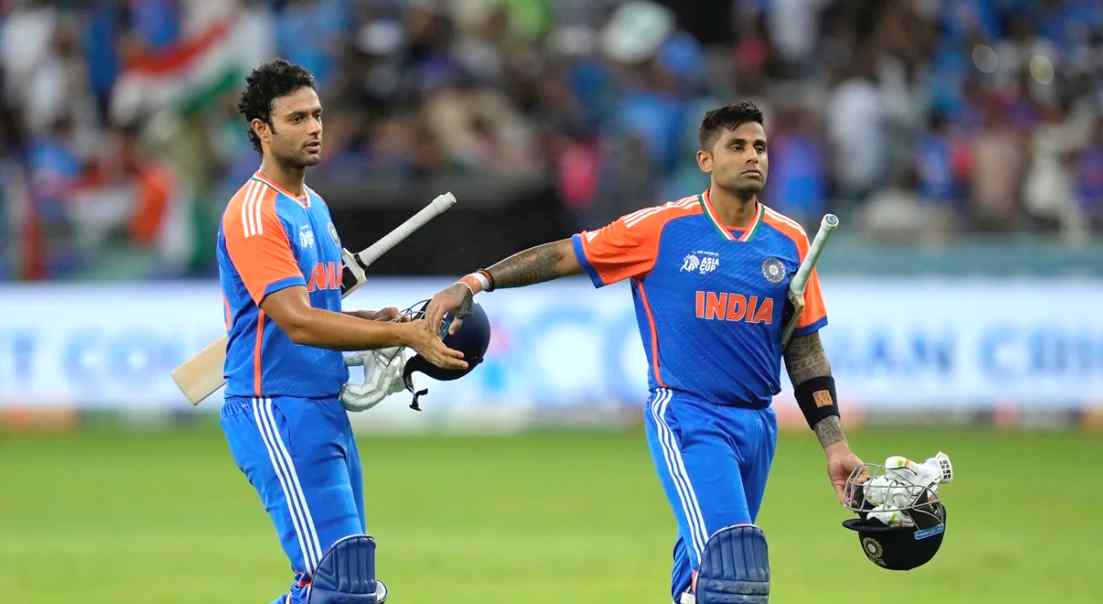No cricket law forces handshakes; Team India justified in skipping post-game ritual as per official regulations.

The so-called ‘handshake gate’ at the Asia Cup 2025 is a classic case of diversionary tactic employed by the Pakistani cricket establishment to distract cricket followers from their humiliating performance on the field against Team India.
This incident has become a hot button for political and media posturing in Pakistan, which can be seen as an attempt to stoke outrage and shift the debate away from hard questions about their team’s capabilities, recent controversial social media behaviour, and uncomfortable geopolitical realities.
What was ‘Handshake Gate’?
The controversy erupted after India’s comprehensive seven-wicket victory over Pakistan in the Asia Cup group match held in Dubai. Instead of participating in the customary post-match handshakes, India captain Suryakumar Yadav and his teammates walked straight off the pitch and into their dressing room, pointedly refusing to engage with the Pakistani players waiting near the dugout.
This snub followed the earlier decision by match referee Andy Pycroft to forgo the pre-toss handshake.
Pakistani cricketers, led by captain Salman Ali Agha, were visibly caught off guard, queuing up in anticipation and approaching the Indian dugout, only to find the doors slammed closed, literally and metaphorically.
The snub was a rare, but not unprecedented, break from cricket’s tradition of sportsmanship. Suryakumar Yadav, when asked, declared, “Some things are beyond sportsmanship,” dedicating the victory, and the stance, to India’s armed forces and the victims of the recent Pahalgam terror attack.
Read More: Asia Cup 2025, IND vs PAK: Kuldeep, Axar spin brilliance sinks Pakistan; India go 3-1 up in Asia Cup T20Is
Handshakes ‘not mandatory’
While the ICC’s “Spirit of Cricket” preamble encourages respect and mutual congratulations, nowhere in the Code of Conduct is the handshake made compulsory. BCCI officials have affirmed that shaking hands is a convention, not a law, and players cannot be penalised for opting out of the gesture, even in tournaments as high-profile and emotionally charged as the Asia Cup.
Reaction from Pakistan
The incident quickly spiraled as the PCB (Pakistan Cricket Board) filed formal complaints with the ICC, demanding the removal of referee Pycroft and threatening to pull out of the tournament in protest if action was not taken.
Pakistan captain Agha refused to attend the post-match presentation and, along with head coach Mike Hesson, expressed public disappointment and anger about India’s conduct. PCB officials issued strongly worded statements, with some even accusing the ICC-appointed referee of violating the spirit of cricket and MCC laws.
Match officials had explicitly permitted India to skip the handshake in view of extreme political tensions and recent violence, but failed to communicate this clearly to the Pakistani contingent. The PCB’s formal protests thus seemed a way to amplify grievances and invoke a sense of victimhood.
Read More: Asia Cup 2025: Gap between India batters & other teams too large – A numerical analysis
The real backdrop
The real context behind ‘handshake gate’ is not just cricket. In April 2025, militants attacked tourists in the Baisaran valley near Pahalgam, Jammu and Kashmir, killing 26 civilians, most of them Hindus, tearing the fabric of secular India.
The attack was claimed by The Resistance Front (TRF), a Pakistan-backed group. India responded with ‘Operation Sindoor’ targeting terror camps in Pakistan-administered territory, followed by a brief but fierce military conflict in May.
This series of flashpoints exacerbated bilateral tensions, with Indian politicians and media calling for a boycott of sporting links. In the midst of these hostilities, offensive social media posts emerged from some Pakistan cricketers, controversial memes and pointed comments glorifying Operation Sindoor’s adversaries or mocking Indian casualties.
India’s stance
Against this backdrop, India’s refusal to engage in handshakes is not mere pettiness or unsportsmanlike behaviour. Cricket is often presented as separate from politics, yet symbolism matters deeply in times of national trauma.
Suryakumar Yadav and the BCCI have maintained that their actions reflected the mood of an outraged nation, one still reeling from the deaths in Pahalgam and ongoing threats. Players explicitly dedicated their win over Pakistan to victims and armed forces personnel.
Far from breaching ICC or MCC codes, India acted with the tacit approval of officials, taking a stand that goes beyond the boundaries of the cricket field. The spirit of sportsmanship cannot be imposed in a vacuum. It must align with the realities of life outside sport, especially when violence, terror, and incitement are at play.
Read More: History of Asia Cup in T20 format: Top batters, bowlers & other numbers
Diversion from dismal performance
The timing and intensity of Pakistan’s outrage is telling. Their team not only lost, but was outclassed in every department, be it batting, fielding, or tactics. Instead of introspection, every media platform, from PCB officials to television pundits, chose to amplify the handshake controversy, saturating headlines with claims about India’s arrogance and disrespect.
Pakistani netizens and influencers poured fuel on the fire, drawing attention away from the technical faults, dropped catches, and lack of fight shown by the team.
Operation Sindoor and offensive posts
The incident also comes in the shadow of controversial social media posts by Pakistani players and supporters mocking Operation Sindoor, the Indian military response to Pahalgam attacks. These posts have been widely condemned in India and beyond as insensitive and incendiary.
Indian officials and the BCCI have stressed the need to maintain dignity, even in response to provocation, a stance that finds support among fans who see the handshake snub as both justified and restrained.
Read More: Asia Cup 2025, UAE vs IND: Kuldeep, Dube run through UAE line-up; India overhaul target in 27 balls

